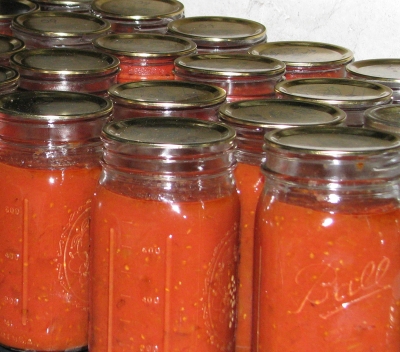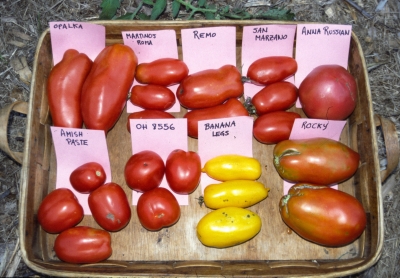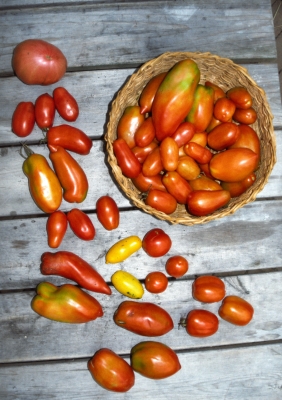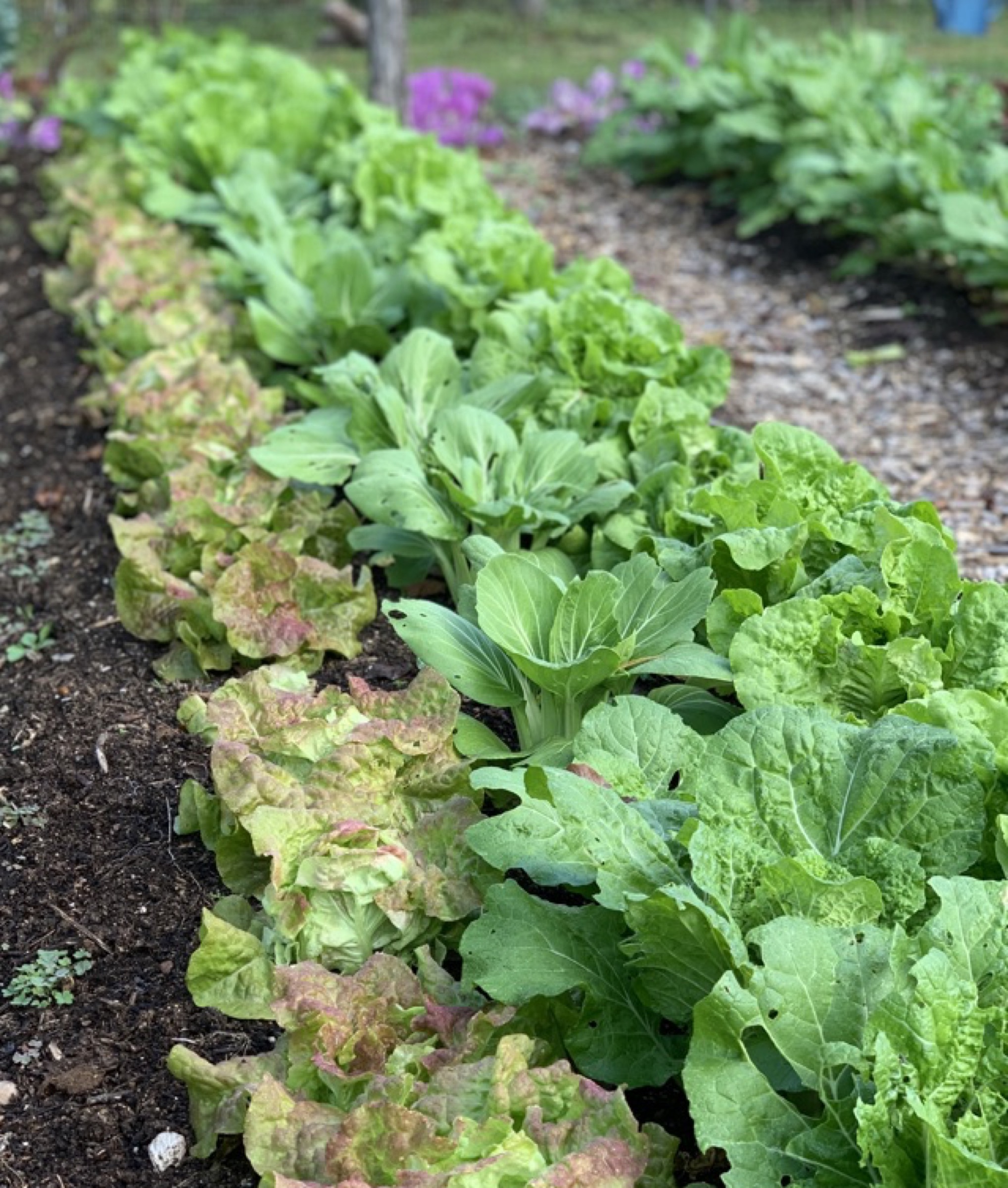AND THE BEST PASTE TOMATO IS . . .
Is a Tomato a Tomato
If a rose is a rose is a rose is a rose, then a tomato is a tomato is a tomato. Or surely a paste tomato is. After all, paste tomatoes are rarely eaten fresh; they are mostly just cooked.
Each summer in my garden, we grow and put up enough canned tomatoes to keep us in soup, stew, and sauce for at least a year.  A couple of summers ago, I sorted through some of the paste tomato varieties available, planting, growing, and evaluating flavors of the reputed best. These were varieties highly touted by seed purveyors, some gardeners, and on the web.
A couple of summers ago, I sorted through some of the paste tomato varieties available, planting, growing, and evaluating flavors of the reputed best. These were varieties highly touted by seed purveyors, some gardeners, and on the web.
I admit to entering this foray with prejudices. One was a bias in favor of San Marzano, a variety that I have grown for years. Fresh, San Marzano is dry, mealy, and bland, but cook it and the flavor turns piquant, oozing tomato-ness.
I also had another prejudice, a bias against the variety Roma, which I have unfortunately grown in the past and is so well-known and available that paste tomatoes sometimes are just called Roma tomatoes. Bland, bland, bland. Other varieties I’ve grown in years past include La Rossa, Viva Italia, and Super Marzano. Like Roma, they were disappointing, not worth including in my trial.
Before going out in the field, let’s try to define a paste tomato. We could say that such tomatoes are all pear-shaped, with thick walls and small seed chambers so the pulp quickly cooks into a thick sauce. Or we could say a paste tomato is any tomato good for cooking in terms of flavor or juiciness, whatever the shape of the fruit. I chose the latter definition after discovering some tomatoes that made delectable sauce were not pear shaped at all.
How Tomatoes Grow
You have to grow paste tomatoes if you want the best. The variety you’re most likely to purchase fresh in the supermarket is that insipid Roma or one of its equally flavorless commercial counterparts. These varieties are also the ones you’re most likely to find lined up alongside other tomato transplants at garden centers and nurseries.
Fortunately, tomatoes are easy to raise from seed. Sow seeds indoors in potting soil six weeks before the average date of your last killing frost. On that last frost date, acclimate the plants to life outdoors by moving them outside on balmy days to a location sheltered from the full forces of wind and sun. After a week or two of “hardening off,” set plants in their permanent homes.
Spacing for tomato plants depends on how you grow them and whether they are “determinate” or “indeterminate” (usually indicated on the seed packet or in the seed catalog). Stems of determinate tomatoes end in flower clusters, so further growth is always from side shoots. Indeterminate tomatoes flower along their stems, so any stem can keep growing until stopped by frost. When you pull off side shoots to prune a staked, indeterminate tomato plant, the result is a single, ever elongating stem with fruits continuously developing and hanging along it at intervals.
Determinate tomatoes and staked, pruned indeterminate tomatoes can be planted as close as eighteen inches apart. Unpruned, indeterminate plants need about five feet between them.
Most paste tomato varieties, especially commercial ones, are determinate. This type of growth habit makes good commercial sense: the squat plants can be grown close together and the ripening period is concentrated, so much so that harvest is often “once over” with a machine. The downside is that the plants produce fewer leaves per fruit, resulting — all other things being equal — in tomatoes with inferior flavor. The stress of concentrated ripening also makes them more susceptible to diseases.
Drum Roll
It was a hot day in August when my taste panel of three sat down for the first tasting session. Although my original plan was to rate the quality of paste tomatoes for their usual purpose — cooking — I decided also to rate them for fresh eating. After all, wouldn’t it be dandy if a variety could yield tomatoes for slicing into sandwiches as well as for simmering down into scrumptious sauces? 
Fresh, San Marzano bore out previous experience, with flavorless fruits. Banana Legs was even worse; what little flavor it did have was bad. Bland, with slight astringency and poor flavor was Ohio 8556 — little wonder with a name that says “plum shaped, red, meaty” and nothing more.
Not awful, but also not good, with passable for fresh eating were Martino’s Roma, Rocky, and San Remo.
A couple of varieties surprised us with good fresh flavors and textures. Anna Russian and Amish Paste were mild but quite tasty. Tops among the lot for fresh eating was Howard’s German, its tangy fruits having plenty of juice and smooth texture.
Next, all samples were simmered for a couple of hours. I expected all plum tomatoes to taste at least passably good cooked. Not so. Banana Legs was the loser again, with a mushy, sickly sweet, off-flavor. Almost as bad was Ohio 8556, which had no body and was slightly astringent. San Remo retained the low rating it had fresh.
Martino’s Roma was good, tangy and rich, but not tomato-y enough.
The consensus for the best tasting tomatoes after cooking included — as predicted — San Marzano. We also gave top honors to Amish Paste for being very full-bodied and rich, and Anna’s Russian, yielding perhaps the most tomato-y flavored stew of the lot and surely the the most intensely red one. Howard German also maintained its high rating.
Although I chose to grow cooking tomatoes that had been given top ratings by others, our ratings followed a bell curve such as would be expected from any diverse population: a few outstanding varieties, a few awful varieties, and many that were just okay. This was true both for fresh and cooked flavor, and the rating for most varieties was different in each category.
Why such a range for the alleged crème de la crème of paste tomatoes? Perhaps because taste is a matter of taste. More probably, it was because we deliberately avoided being distracted by yield, harvest window, disease resistance, or any other quality except flavor — the main reason, in my opinion, for plucking tomatoes from backyard plants rather than market shelves.




Amish Paste is my favorite pasts tomato. I’ve grown many others in the past, but always return to the willowy Amish Paste. Reliably great even under poor growing conditions.
Thank you for this. I live in Central CA zone 9, and work 7 days per week in, (smile), a tomato cannery. I grow all my tomatoes from seed, and have hardly any time to tend, (prune), my postage stamp sized garden. I grow tomatoes, including
Marzano, in ground and in raised beds. I even have 2 Patio Choice plants in a garden tower!) I’m also trying a couple dwarf tomatoes this year. I’m going to try Howard’s German and Anna’s Russian next year because I’ve neither room, nor time for growing insipid tomatoes, and would love to find a decent dual- purpose canning/slicing tomato.
Much appreciation for the article!
Glad the post helped. Report back on how my two recommendations perform.
I also love and grow San Marzano and I have several suggestions for those who enjoy paste/sauce tomatoes. Dix Doights di Napoli (Ten Fingers of Naples); it is highly productive and very close to San Marzano but with a tighter growth habit. StoneRidge; a large and dense plant the fruits of which ripen late but is delicious both fresh eaten and made into a rich albeit sweeter sauce. Justine. I obtained the seeds for this variety by saving some from plants that came from Midwood Gardens in Bergen County, NJ. Claire, the owner of Midwood, had obtained the seeds from a woman named Justine when she visited Italy. The fruits ripened very late though. I embarked on a breeding project and over the course of a decade I was able to take 3 weeks off the ripening time while still preserving the attributes I wanted in the fruits. Those attributes are flavor and size. Justine produces large pear shaped fruits that are a gentle red. They are good for fresh eating, making into sauce, and canning. The only negative is the rather tough core at the stem end of the fruit (these go to the chickens). If you find the seeds listed in a catalogue, you will have found the fruits of my labors as I gave them to friends who had small seed businesses and I have noticed them listed in various small seed companies’ catalogues.
Thanks for the recommends, Robert. I’ll keep my eye out for Justine even though I’m happy with the varieties I grow and too often have been disappointed when growing recommendations frm otheres.
Here just outside Portland, Oregon, we gardeners struggle badly with Blossom End Rot on tomatoes, and San Marzano is one of the worst offenders. Too bad, because its flavor is really excellent. I’m trying a few BER resistant tomatoes this year.
I agree about BER and San Marzano although it’s not too bad here. You probably know this, but maintaining consistently moist soil, mulching, and making sure soil has sufficient Ca helps. Also, staked tomatoes are more prone to BER than sprawling ones.
There is mycorrhizae for rot.
Can you write about ericoid too?
I’ll think about writing about ericoid mycorrhizae; that was one area of my doctoral research. Please explain what you mean by “mycorrhizae for rot.”
I meant that arbuscular mycorrhizae (available from Home Depot) can out-compete “water molds” and increase the uptake of nutrients (calcium included) improving taste too.
Please consider blogging about any new or interesting tricks of your speciality blueberry mycorrhizae, even beyond your 2017 blog. Your expert writing is so understandable and entertaining,
I wish I could report something more earthshaking, but inn the experiments I performed with and without the ericoid mycorrhizae, noon-inoculated plants also became mycorrhizal. Perhaps the spores are very ubiquitous. However, if I remember correctly, when blueberries were introduced into Australia, growthh was improved.
Inoculation with arbuscular mycorrhizae would have little benefit.
I used to experience some BER though I’ve never had it affect SM that badly. I almost never see it anymore and I attribute that to adding 1/4 cup of natural rock phosphate (high in P and Ca) to each planting hole.
Glad you rarely see it any more but am skeptical about the reason being rock phosphate — unless you did’t treat some plants and can compare BER on treated vs untreated.
That’s usually from irregular watering
Your picture shows an Opalka, but you don’t mention it in your tasting test. I’ve grown this challenging tomato for several years and have found it to be excellent fresh, slow roasted or used for pizza and tomato sauce.
An oversight. I found Opalka to be quite good fresh and cooked, but not up there with the top paste tomatoes. It was somewhat bland.
In the Southern Exposure Seed Exchange catalog they have a variety called Super Italian Paste. They say they are 6-8 ounce fruits and are high yielding. True Leaf Market says they get to 10 ounces. Any experience with them?
No, I haven’t grown or tasted them. But Im most interested in flavor when it comes to tomatoes.
This is my favorite paste tomato, tastes great fresh from the garden and makes a great sauce. They grow very well in our short Wisconsin growing season.
Thank you for your input. I am on the Illinois/Wisconsin border near Lake Michigan so my growing season is a little shorter as well.
Are you only rating open pollinated tomatoes? I have grown “Juliet” as my paste tomato. The crop is plentiful and the taste for sauce is what this Italian likes best.
My favorite paste tomato in Supper Italian Paste, my dad calls the torpedoes, they grow very will in our short Wisconsin growing season. They taste great eating fresh from the garden and make a great tasting sauce.
Is it true that paste tomatoes survive and set fruit better in hot and dry weather than slicers?
I never heard, read, or experienced that.
What drew me to this site was San Remo tomato. I have been trying to find the seed for a long time. It was my favorite tomato to grow. I lost my seeds and then suddenly there was no one to order from. Please let me know where I can get some.
It turns out that San Remo is also known as Pompeii. Seeds are available reneesgarden.com and reimerseeds.com
I’m growing the Anna Russian this year. Supposedly the gene for cold is also the gene for hot. I should clarify, because I’m in Houston Texas, I’m growing the Anna Russian for my fall crop. I tried the San Marzano Hybrid that is supposed to be better, but I didn’t like the taste. I haven’t found one bad word about the Anna Russian.
I agree. Id that generally true for tomatoes, a gene for both hot and cold tolerance?
I ordered seeds from Southern Exposure Seed Exchange for both Amish Paste and Super Italian Paste. I started 4 seeds of each and had 100% germination for both. I was only planning on 2 of each in my garden so I transplanted the 2 strongest looking plants of each. I always thought that past tomato plants were determinant types. Both of the “Amish Paste ones are definitely Indeterminant types and are setting small (handball sized) globe shaped fruits. I’m going to go out on a limb and say they aren’t Amish Paste…
No, not all paste tomatoes are determinate. Amish Paste, for example, is indeterminate. Same with San Marzano. Generally, indeterminate tomatoes taste better than determinate.
I would say from experience that it’s not likely to be the case. Plants and animals respond to different evolutionary pressures in different ways – that’s why, generally, plants endemic to the tropics don’t do well in the cold and vice versa.
In my experience, trying to grow Russian tomato varieties (particularly the dark-skinned ones) in the humid subtropics wasn’t super successful. Could have been the humidity rather than the heat…but to me it stands to reason that a plant bred to thrive in a cold Russian climate is less likely to thrive in a hot, humid climate. YMMV, you can always try out a bunch of varieties and see how it goes in your particular climate